2016 MITSUBISHI OUTLANDER SPORT stop start
[x] Cancel search: stop startPage 334 of 398
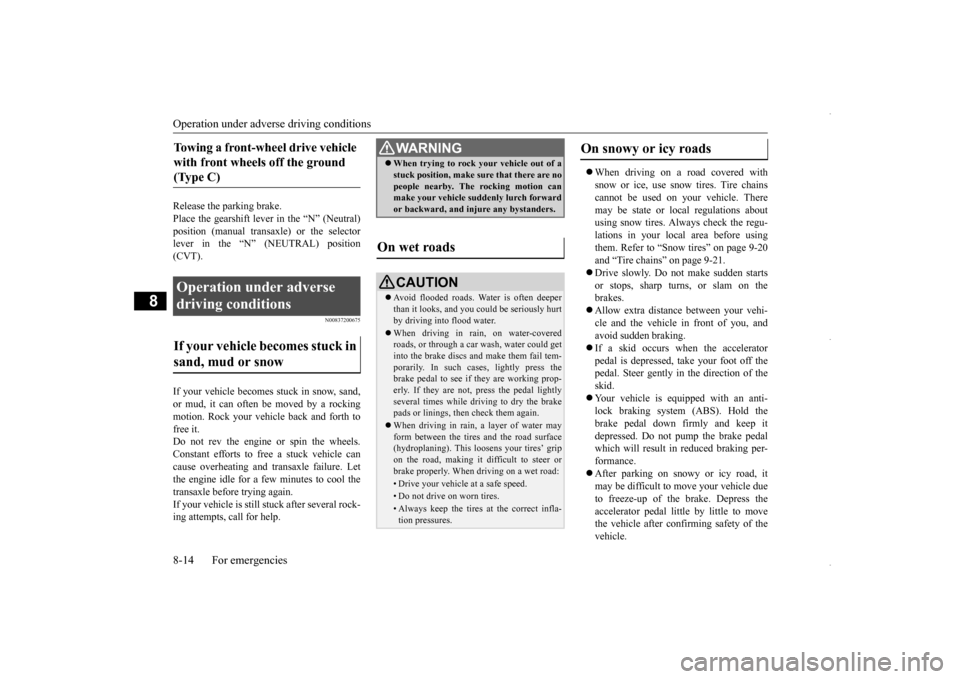
Operation under adverse driving conditions 8-14 For emergencies
8
Release the parking brake. Place the gearshift lever in the “N” (Neutral) position (manual transaxle) or the selector lever in the “N” (NEUTRAL) position(CVT).
N00837200675
If your vehicle becomes stuck in snow, sand,or mud, it can often be
moved by a rocking
motion. Rock your vehicle back and forth to free it.Do not rev the engine or spin the wheels. Constant efforts to free a stuck vehicle can cause overheating and transaxle failure. Letthe engine idle for a few minutes to cool the transaxle before trying again. If your vehicle is still stuck after several rock-ing attempts, call for help.
When driving on a road covered with snow or ice, use snow tires. Tire chains cannot be used on your vehicle. Theremay be state or local regulations about using snow tires. Always check the regu- lations in your local area before usingthem. Refer to “Snow tires” on page 9-20 and “Tire chains” on page 9-21. Drive slowly. Do not make sudden starts or stops, sharp turns, or slam on thebrakes. Allow extra distance between your vehi- cle and the vehicle in front of you, andavoid sudden braking. If a skid occurs when the accelerator pedal is depressed, take your foot off thepedal. Steer gently in the direction of the skid. Your vehicle is equipped with an anti- lock braking system (ABS). Hold the brake pedal down firmly and keep it depressed. Do not pump the brake pedalwhich will result in reduced braking per- formance. After parking on snowy or icy road, it may be difficult to move your vehicle due to freeze-up of the brake. Depress the accelerator pedal little by little to movethe vehicle after confirming safety of the vehicle.
Towing a front-wheel drive vehicle with front wheels off the ground (Type C) Operation under adverse driving conditions If your vehicle becomes stuck in sand, mud or snow
WA R N I N G When trying to rock your vehicle out of a stuck position, make sure that there are no people nearby. The rocking motion can make your vehicle suddenly lurch forward or backward, and injure any bystanders.
On wet roads
CAUTION Avoid flooded roads. Water is often deeper than it looks, and you could be seriously hurt by driving into flood water. When driving in rain, on water-covered roads, or through a car wash, water could getinto the brake discs and make them fail tem- porarily. In such cases, lightly press the brake pedal to see if they are working prop-erly. If they are not, press the pedal lightly several times while driving to dry the brake pads or linings, then check them again. When driving in rain, a layer of water may form between the tires and the road surface(hydroplaning). This loosens your tires’ grip on the road, making it difficult to steer or brake properly. When driving on a wet road:• Drive your vehicle at a safe speed.• Do not drive on worn tires.• Always keep the tires at the correct infla- tion pressures.
On snowy or icy roads
BK0229600US.bo
ok 14 ページ 2015年10月1日 木曜日 午後2時29分
Page 335 of 398
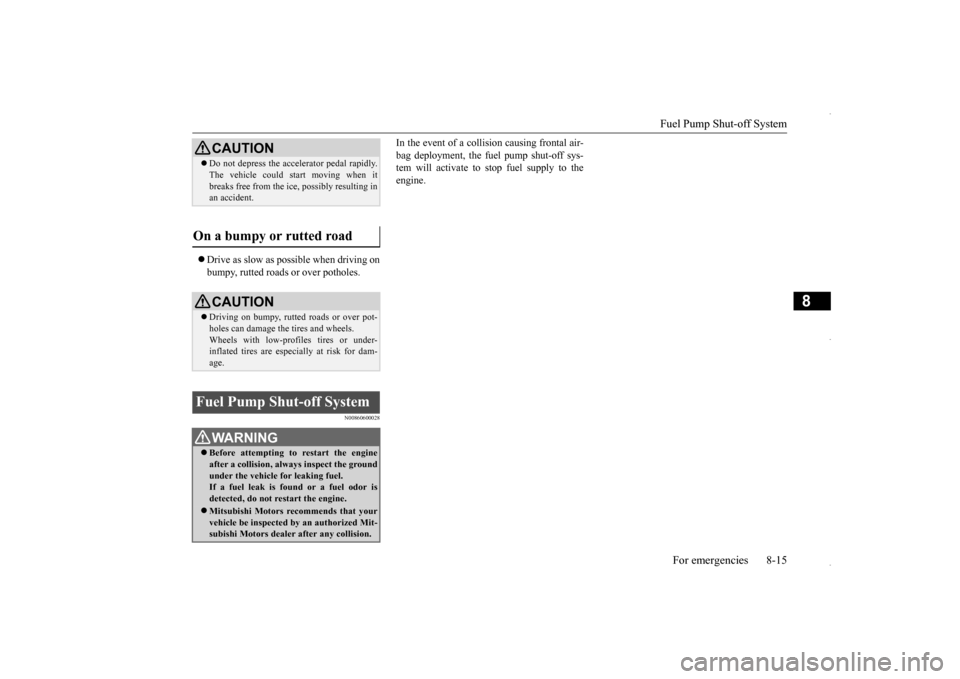
Fuel Pump Shut-off System
For emergencies 8-15
8
Drive as slow as poss
ible when driving on
bumpy, rutted roads or over potholes.
N00860600028
In the event of a collision causing frontal air-bag deployment, the fuel pump shut-off sys- tem will activate to stop fuel supply to the engine.
CAUTION Do not depress the accelerator pedal rapidly. The vehicle could start moving when it breaks free from the ice, possibly resulting in an accident.
On a bumpy or rutted road
CAUTION Driving on bumpy, rutted roads or over pot- holes can damage the tires and wheels. Wheels with low-profiles tires or under- inflated tires are especially at risk for dam-age.
Fuel Pump Shut-off System
WA R N I N G Before attempting to restart the engine after a collision, always inspect the ground under the vehicle for leaking fuel. If a fuel leak is found or a fuel odor isdetected, do not restart the engine. Mitsubishi Motors recommends that your vehicle be inspected by an authorized Mit- subishi Motors dealer after any collision.
BK0229600US.bo
ok 15 ページ 2015年10月1日 木曜日 午後2時29分
Page 339 of 398
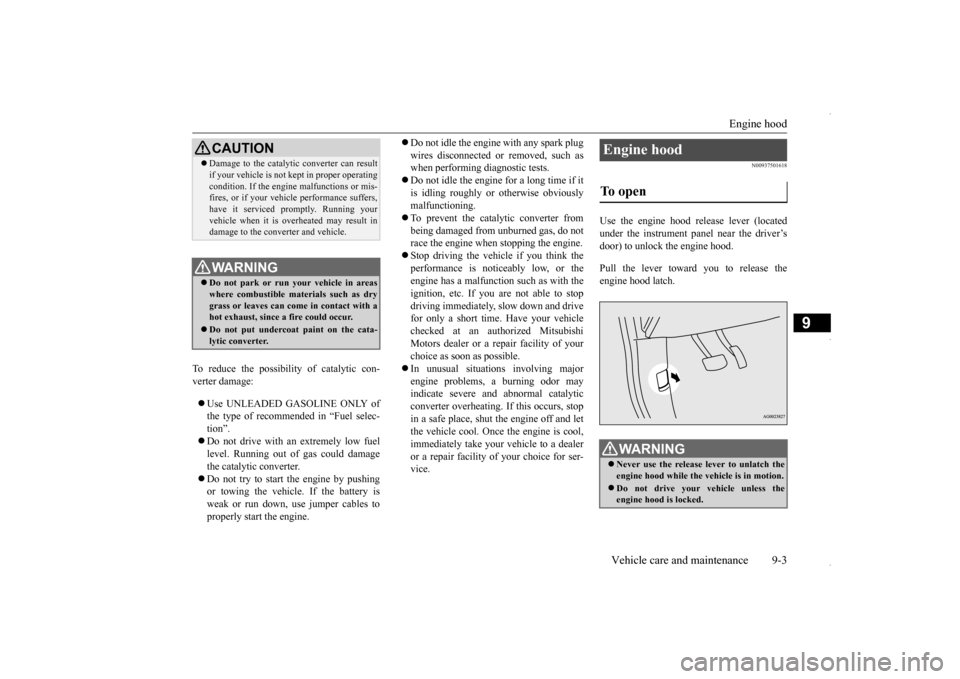
Engine hood
Vehicle care and maintenance 9-3
9
To reduce the possibility of catalytic con- verter damage: Use UNLEADED GASOLINE ONLY of the type of recommended in “Fuel selec- tion”. Do not drive with an extremely low fuel level. Running out of gas could damage the catalytic converter. Do not try to start the engine by pushing or towing the vehicle. If the battery is weak or run down, use jumper cables to properly start the engine.
Do not idle the engine with any spark plug wires disconnected or removed, such as when performing diagnostic tests. Do not idle the engine for a long time if it is idling roughly or otherwise obviously malfunctioning. To prevent the catalytic converter from being damaged from unburned gas, do not race the engine when stopping the engine. Stop driving the vehicle if you think the performance is noticeably low, or theengine has a malfunction such as with the ignition, etc. If you
are not able to stop
driving immediately, slow down and drivefor only a short time. Have your vehicle checked at an authorized Mitsubishi Motors dealer or a repair facility of yourchoice as soon as possible. In unusual situations involving major engine problems, a burning odor mayindicate severe and abnormal catalytic converter overheating. If this occurs, stop in a safe place, shut the engine off and letthe vehicle cool. Once the engine is cool, immediately take your vehicle to a dealer or a repair facility of your choice for ser-vice.
N00937501618
Use the engine hood release lever (locatedunder the instrument panel near the driver’sdoor) to unlock the engine hood. Pull the lever toward you to release the engine hood latch.
CAUTION Damage to the catalytic converter can result if your vehicle is not kept in proper operating condition. If the engine malfunctions or mis- fires, or if your vehicle performance suffers, have it serviced promptly. Running yourvehicle when it is overheated may result in damage to the converter and vehicle.WA R N I N G Do not park or run your vehicle in areas where combustible materials such as dry grass or leaves can come in contact with a hot exhaust, since a fire could occur. Do not put undercoat paint on the cata- lytic converter.
Engine hood To open
WA R N I N G Never use the release lever to unlatch the engine hood while the vehicle is in motion. Do not drive your vehicle unless the engine hood is locked.
BK0229600US.bo
ok 3 ページ 2015年10月1日 木曜日 午後2時29分
Page 349 of 398
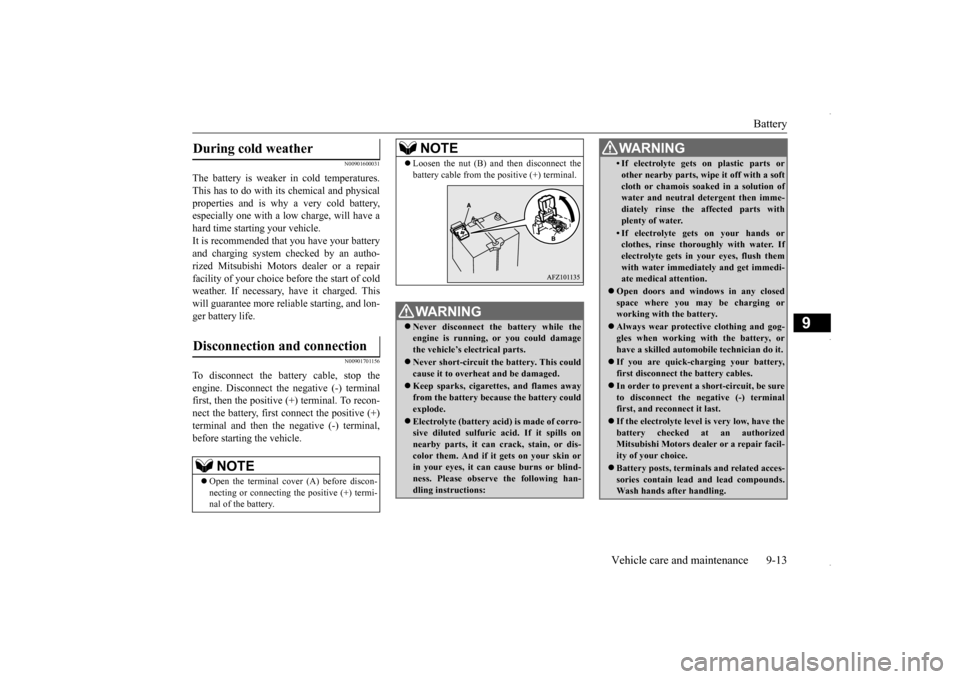
Battery
Vehicle care and maintenance 9-13
9
N00901600031
The battery is weaker in cold temperatures. This has to do with its chemical and physicalproperties and is why a very cold battery, especially one with a low charge, will have a hard time starting your vehicle.It is recommended that you have your battery and charging system checked by an autho- rized Mitsubishi Motors dealer or a repairfacility of your choice before the start of coldweather. If necessary, have it charged. This will guarantee more reliable starting, and lon- ger battery life.
N00901701156
To disconnect the battery cable, stop theengine. Disconnect the negative (-) terminalfirst, then the positive (+) terminal. To recon- nect the battery, first connect the positive (+) terminal and then the negative (-) terminal,before starting the vehicle.During cold weather Disconnection and connection
NOTE
Open the terminal cover (A) before discon- necting or connecting the positive (+) termi- nal of the battery.
Loosen the nut (B) and then disconnect the battery cable from the positive (+) terminal.WA R N I N G Never disconnect the battery while the engine is running, or you could damagethe vehicle’s electrical parts. Never short-circuit the battery. This could cause it to overheat and be damaged. Keep sparks, cigarettes, and flames away from the battery because the battery could explode. Electrolyte (battery acid) is made of corro- sive diluted sulfuric
acid. If it spills on
nearby parts, it can crack, stain, or dis-color them. And if it gets on your skin or in your eyes, it can cause burns or blind- ness. Please observe the following han- dling instructions:NOTE
• If electrolyte gets on plastic parts orother nearby parts, wi
pe it off with a soft
cloth or chamois soaked in a solution of water and neutral detergent then imme- diately rinse the affected parts withplenty of water.• If electrolyte gets on your hands orclothes, rinse thoroughly with water. If electrolyte gets in your eyes, flush them with water immediately and get immedi-ate medical attention.
Open doors and windows in any closed space where you may be charging or working with the battery. Always wear protective clothing and gog- gles when working with the battery, or have a skilled automobile technician do it. If you are quick-charging your battery, first disconnect the battery cables. In order to prevent a short-circuit, be sure to disconnect the negative (-) terminalfirst, and reconnect it last. If the electrolyte level is very low, have the battery checked at an authorized Mitsubishi Motors dealer or a repair facil- ity of your choice. Battery posts, terminals and related acces- sories contain lead and lead compounds. Wash hands after handling.WA R N I N G
BK0229600US.bo
ok 13 ページ 2015年10月1日 木曜日 午後2時29分
Page 395 of 398
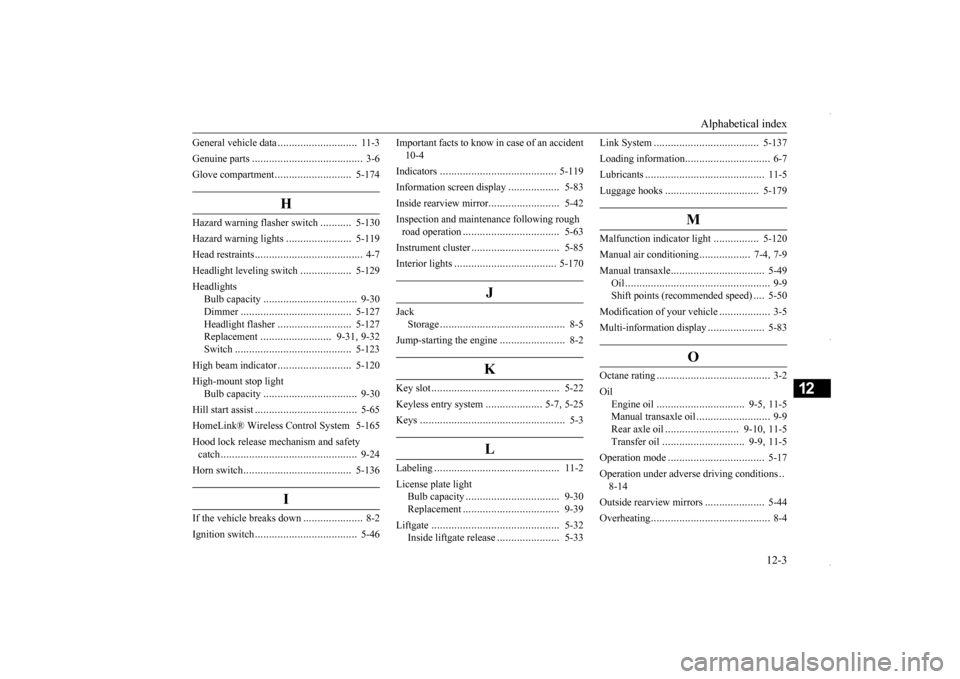
Alphabetical index
12-3
12
General vehicle data
............................
11-3
Genuine parts
....................
...................
3-6
Glove compartment
...........................
5-174
H
Hazard warning flasher switch
...........
5-130
Hazard warning lights
.......................
5-119
Head restraints
...................
...................
4-7
Headlight leveling switch
..................
5-129
Headlights
Bulb capacity
................
.................
9-30
Dimmer
....................
...................
5-127
Headlight flasher
..........................
5-127
Replacement
.........................
9-31
, 9-32
Switch
......................
...................
5-123
High beam indicator
..........................
5-120
High-mount stop light
Bulb capacity
................
.................
9-30
Hill start assist
...................
.................
5-65
HomeLink® Wireless Control System 5-165Hood lock release mechanism and safety catch
........................
........................
9-24
Horn switch
...................
...................
5-136
I
If the vehicle breaks down
.....................
8-2
Ignition switch
...................
.................
5-46
Important facts to know in case of an accident 10-4 Indicators
....................
.....................
5-119
Information screen display
..................
5-83
Inside rearview mirror
.........................
5-42
Inspection and maintenance following rough road operation
...................
...............
5-63
Instrument cluster
................
...............
5-85
Interior lights
...................
.................
5-170
J
Jack
Storage
........................
....................
8-5
Jump-starting the engine
.......................
8-2
K
Key slot
.......................
......................
5-22
Keyless entry system
....................
5-7
, 5-25
Keys
...........................
........................
5-3
L
Labeling
......................
......................
11-2
License plate light
Bulb capacity
..................
...............
9-30
Replacement
...................
...............
9-39
Liftgate
.......................
......................
5-32
Inside liftgate release
......................
5-33
Link System
..................
...................
5-137
Loading information
..............................
6-7
Lubricants
.....................
.....................
11-5
Luggage hooks
..................
...............
5-179
M
Malfunction indicator light
................
5-120
Manual air conditioning
..................
7-4
, 7-9
Manual transaxle
................
.................
5-49
Oil
............................
.......................
9-9
Shift points (recommended speed)
....
5-50
Modification of your vehicle
..................
3-5
Multi-information display
....................
5-83
O
Octane rating
.....................
...................
3-2
Oil
Engine oil
...............................
9-5
, 11-5
Manual transaxle oil
..........................
9-9
Rear axle oil
..........................
9-10
, 11-5
Transfer oil
.............................
9-9
, 11-5
Operation mode
.................
.................
5-17
Operation under adverse driving conditions
..
8-14 Outside rearview mirrors
.....................
5-44
Overheating
.......................
...................
8-4
BK0229600US.bo
ok 3 ページ 2015年10月1日 木曜日 午後2時29分
Page 396 of 398

Alphabetical index 12-4
12
P
Parking
.........................
.......................
6-6
Parking brake break-in
....................
9-21
Parking brake lever stroke
...............
9-21
Parking brake
....................
.................
5-40
Parking lights (type 1)
Bulb capacity
................
.................
9-30
Parking lights (type 2)
Bulb capacity
................
.................
9-30
Polishing
.......................
.....................
9-43
Power brakes
.....................
.................
5-64
Power outlet
..................
...................
5-164
Power steering
Fluid
........................
.....................
11-5
Power windows
.................
.................
5-37
Puncture (Tire changing)
.......................
8-6
R
Radio
General information about your radio 7-63
Reading lights
Bulb capacity
................
.................
9-31
Rear axle oil
...............
...............
9-10
, 11-5
Rear combination lights
Bulb capacity
................
.................
9-30
Replacement
.................
.................
9-37
Rear side-marker lights
Bulb capacity
..................
................
9-30
Replacement
...................
................
9-37
Rear turn signal light
Bulb capacity
..................
................
9-30
Replacement
...................
................
9-37
Rear-view camera
...............
................
5-81
Rearview mirror
Inside rearview mirror
.....................
5-42
Outside rearview mirrors
.................
5-44
Replacement of light bulbs
...................
9-29
Replacing tires and wheels
...................
9-19
Reporting Safety Defects
.....................
10-2
S
Safe driving techniques
.........................
6-4
Seat belt
......................
.......................
4-11
Adjustable seat belt shoulder anchor
.4-16
Child restraint systems
.....................
4-18
Front passenger seat belt warning light
.....
4-16Maintenance and inspection
.............
4-25
Seat belt extender
............................
4-17
Seat belt force limitter
.....................
4-18
Seat belt pre-tensioners
....................
4-17
Seat belt use during pregnancy
.........
4-17
Seats
...........................
........................
4-2
Arm rest
......................
....................
4-7
Front seats
...................
....................
4-3
Head restraints
................
.................
4-7
Heated seat
...................
...................
4-6
Seats and restraint systems
................
4-2
Service brake
.....................
.................
5-64
Service precautions
...............
................
9-2
Side turn signal light
Bulb capacity
................
.................
9-30
Replacement
.................
.................
9-35
Snow tires
.....................
.....................
9-20
Spark plugs
...................
.....................
9-22
Starting the engine
..............................
5-47
Steering
Power steering fluid
........................
11-5
Steering wheel height and reach adjustment 5-41
Stop lights
Bulb capacity
................
.................
9-30
Replacement
.................
.................
9-37
Storage spaces
...................
...............
5-174
Sun visors
.....................
...................
5-163
Sunshade
......................
.....................
5-39
Supplemental Restraint System
............
4-26
How the Supplemental Restraint System works
.....................
.....................
4-28
Maintenance service
.......................
4-41
T
Tail light
Bulb capacity
................
.................
9-30
BK0229600US.bo
ok 4 ページ 2015年10月1日 木曜日 午後2時29分